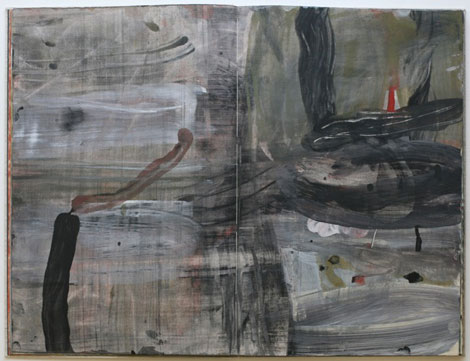The buzz around San Francisco’s new art hub—near the Design District along a stretch of Utah Street and nearby Potrero—resonates throughout Jack Fischer’s expansive new space. Its inaugural exhibition, “Years of Pretty,” is a mini-retrospective of SF-based Ward Schumaker’s work from the past 10 years.
Schumaker’s day job for 35 years has been commercial illustration for clients like Hermès and Kronenbourg. While his hand is finely trained, in his fine artwork he chooses to let other energies come into play. Roughly brushed, intuitively composed paintings mix randomness and design, the skillfulness of the hand revealing itself slyly in the flip of a brushstroke—the blunt, ragged dragging of paint which obliterates text just so.
While Schumaker presents his gestural musings in a variety of formats, it is the presence of seven hand-painted books that carry the most weight. The hefty books on Stonehenge paper mesh expressionistic paint-handling with washy fields, at times disrupted by stenciled text. Beneath Krakatoa (2004) offers dense black passages enlivened by brush tracks or faint gestural figurative suggestions in hues of pink or red, the rich, energetically composed fields in effect constituting a thick stack of paintings packed back-to-back between bindings.
It was in a class at the San Francisco Center for the Book where the artist first experimented with mixing bookbinding paste into acrylic paint. The resulting pages caught the eye of a gallerist from Shanghai, who offered to show them as paintings. The work has since drawn attention from many in the art world—finding its way into the collections of Eric Fischl and Ivan Karp, among others. Schumaker enjoys the hard, tactile quality and glossy sheen that the medium lends to the work, stating that it adds an element of uncertainty, which he enjoys.
Elixir Refused (Make Happy) (2005) draws narrative from the Bhagavad Gita, while Weather Patterns (2003) offers atmospheric fields of apricot and pale aqua broken by quirky biomorphic forms. As one becomes immersed in Schumaker’s images, it’s almost a process of getting to know how he thinks. Certainly for those with a painterly orientation the work compels prolonged viewing, soaking in the impressions of form and color both as visual nourishment and as a challenge to decipher technique and meaning.
Rounding out the exhibition are large and small wall-mounted works along with his “dumb boxes,” an assortment of sculptural objects combining geometric forms, cubes, rectangles and sloping planes, with roughly applied geometric designs. One-eyed Afternoon (2012) features a pair of cubes, 7” on a side, joined across the bottom by a plane on which they both rest. Roughly brushed with white gesso, the interior spaces are tightly filled with squares of corrugated cardboard.
While elusive snippets of text throughout intrigue and tease, some, such as the repeated phrase “I Am Big Heaven,” clearly demand attention. Schumaker maintains an active meditation practice, and one might reasonably conjecture that these words are offered as a form of mantra for both artist and viewer to latch on to—if only in order to let go.



















0 Comments